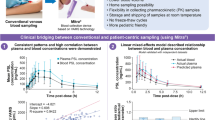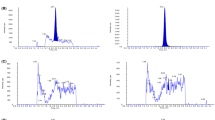Abstract
Purpose
Various blood collection methods were developed and used in the pharmacokinetic evaluation of drugs. However, the influence of different blood sampling methods on plasma drug concentrations has not been clarified. In the present study, we aimed to determine whether the plasma concentration of a target drug changes based on the collection site and elucidate the mechanism responsible for this change.
Methods
We compared three blood sampling methods commonly used in small animals. Eight clinical drugs were selected and administered to rats simultaneously via intracardiac injection or oral gavage. Blood samples were collected from different sites at the same individual, and pharmacokinetic properties of the drugs were then evaluated.
Results
Study results showed that the maximum plasma concentration or area under the curve of three study drugs was significantly higher in rats when blood was sampled from the carotid artery than when it was sampled from the caudal vein or by tail snip.
Conclusions
Pharmacokinetics of certain drugs may differ based on the blood sampling site. The acid-base properties of drugs may influence pharmacokinetic evaluation. The rate and extent of drug distribution may also cause such differences and have significant effects on plasma drug levels.



Similar content being viewed by others
References
Panchagnula R, Thomas NS. Biopharmaceutics and pharmacokinetics in drug research. Int J Pharm. 2000;201(2):131–50.
Jang GR, Harris RZ, Lau DT. Pharmacokinetics and its role in small molecule drug discovery research. Med Res Rev. 2001;21(5):382–96.
Perrin S. Preclinical research: make mouse studies work. Nature. 2014;507(7493):423–5.
Hui YH, Huang NH, Ebbert L, Bina H, Chiang A, Maples C, et al. Pharmacokinetic comparisons of tail-bleeding with cannula- or retro-orbital bleeding techniques in rats using six marketed drugs. J Pharmacol Toxicol Methods. 2007;56(2):256–64.
Illum L, Hinchcliffe M, Davis SS. The effect of blood sampling site and physicochemical characteristics of drugs on bioavailability after nasal administration in the sheep model. Pharm Res. 2003;20(9):1474–84.
Darwish M, Kirby M, Robertson P Jr, Hellriegel E, Jiang JG. Comparison of equivalent doses of fentanyl buccal tablets and arteriovenous differences in fentanyl pharmacokinetics. Clin Pharmacokinet. 2006;45(8):843–50.
Johannessen WM, Tyssebotn IM, Aarbakke J. Antipyrine and acetaminophen kinetics in the rat: comparison of data based on blood samples from the cut tail and acannulated femoral artery. J Pharm Sci. 1982;71(12):1352–6.
Parasuraman S, Raveendran R, Kesavan R. Blood sample collection in small laboratory animals. J Pharmacol Pharmacother. 2010;1(2):87–93.
Chiou WL. The phenomenon and rationale of marked dependence of drug concentration on blood sampling site. Implications in pharmacokinetics, pharmacodynamics, toxicology and therapeutics (part I). Clin Pharmacokinet. 1989;17(3):175–99.
de Pont AC, Hofstra JJ, Pik DR, Meijers JC, Schultz MJ. Pharmacokinetics and pharmacodynamics of danaparoid during continuous venovenous hemofiltration: a pilot study. Crit Care. 2007;11(5):R102.
Wu CY, Benet LZ. Predicting drug disposition via application of BCS: transport/absorption/ elimination interplay and development of a biopharmaceutics drug disposition classification system. Pharm Res. 2005;22(1):11–23.
Benet LZ, Broccatelli F, Oprea TI. BDDCS applied to over 900 drugs. AAPS J. 2011;13(4):519–47.
Hosey CM, Chan R, Benet LZ. BDDCS predictions, self-correcting aspects of BDDCS assignments, BDDCS assignment corrections, and classification for more than 175 additional drugs. AAPS J. 2016;18(1):251–60.
Ahmad M, Qamar-uz-Zaman M, Madni MA, Minhas M, Atif M, Naveed A, et al. Pharmacokinetic and bioavailability studies of commercially available simvastatin tablets in healthy and moderately hyperlipidemic human subjects. J Chem Soc Pak. 2011;33(1):49–54.
Gertz M, Harrison A, Houston JB, Galetin A. Prediction of human intestinal first-pass metabolism of 25 CYP3A substrates from in vitro clearance and permeability data. Drug Metab Dispos. 2010;38(7):1147–58.
Wu X, Whitfield LR, Stewart BH. Atorvastatin transport in the Caco-2 cell model: contributions of P-glycoprotein and the proton-monocarboxylic acid co-transporter. Pharm Res. 2000;17(2):209–15.
Lee JB, Zgair A, Taha DA, Zang X, Kagan L, Kim TH, et al. Quantitative analysis of lab-to-lab variability in Caco-2 permeability assays. Eur J Pharm Biopharm. 2017;114:38–42.
Li J, Wang Y, Zhang W, Huang Y, Hein K, Hidalgo IJ. The role of a basolateral transporter in rosuvastatin transport and its interplay with apical breast cancer resistance protein in polarized cell monolayer systems. Drug Metab Dispos. 2012;40(11):2102–8.
Yazdanian M, Briggs K, Jankovsky C, Hawi A. The “high solubility” definition of the current FDA guidance on biopharmaceutical classification system may be too strict for acidic drugs. Pharm Res. 2004;21(2):293–9.
Rege BD, Yu LX, Hussain AS, Polli JE. Effect of common excipients on Caco-2 transport of low-permeability drugs. J Pharm Sci. 2001;90(11):1776–86.
Wang HJ, Hsiong CH, Pao LH, Chang WL, Zhang LJ, Lin MJ, et al. New finding of nalbuphine metabolites in men: NMR spectroscopy and UPLCMS/MS spectrometry assays in a pilot human study. Metabolomics. 2014;10(4):709–18.
U.S. Food and Drug Administration. Bioanalytical method validation guidance for industry. 2018 May 21. Available from: https://www.fda.gov/downloads/drugs/guidances/ucm070107.pdf.
European medicines agency. Guideline on bioanalytical method validation. 2011 July 21. Available from: https://www.ema.europa.eu/documents/scientific-guideline/guideline-bioanalytical-method-validation_en.pdf.
Chen X, Deng P, Dai X, Zhong D. Simultaneous determination of amodiaquine and its active metabolite in human blood by ion-pair liquid chromatography-tandem mass spectrometry. J Chromatogr B Anal Technol Biomed Life Sci. 2007;860(1):18–25.
Matuszewski BK, Constanzer ML, Chavez-Eng CM. Strategies for the assessment of matrix effect in quantitative bioanalytical methods based on HPLC-MS/MS. Anal Chem. 2003;75(13):3019–30.
Samaja M, Allibardi S, Milano G, Neri G, Grassi B, Gladden LB, et al. Differential depression of myocardial function and metabolism by lactate and H+. Am J Phys. 1999;276(1 Pt 2):H3–8.
Tsamandouras N, Dickinson G, Guo Y, Hall S, Rostami-Hodjegan A, Galetin A, et al. Development and application of a mechanistic pharmacokinetic model for simvastatin and its active metabolite simvastatin acid using an integrated population PBPK approach. Pharm Res. 2015;32(6):1864–83.
Lipinski CA, Lombardo F, Dominy BW, Feeney PJ. Experimental and computational approaches to estimate solubility and permeability in drug discovery and development settings. Adv Drug Deliv Rev. 2001;46(1-3):3–26.
Liu X, Chen C, Hop CE. Do we need to optimize plasma protein and tissue binding in drug discovery? Curr Top Med Chem. 2011;11(4):450–66.
Pellegatti M, Pagliarusco S, Solazzo L, Colato D. Plasma protein binding and blood-free concentrations: which studies are needed to develop a drug? Expert Opin Drug Metab Toxicol. 2011;7(8):1009–20.
Shargel L, Andrew B, Wu-Pong S. Applied biopharmaceutics & pharmacokinetics. New York: McGraw-Hill Medical Publishing Division; 2015.
Gibaldi M, Perrier D. Pharmacokinetics (Drugs and the Pharmaceutical Sciences). New York: CRC Press; 1982.
Kwon Y. Handbook of essential pharmacokinetics, pharmacodynamics and drug metabolism for industrial scientists. New York: Springer; 2001.
Smith DA, Beaumont K, Maurer TS, Di L. Volume of distribution in drug design. J Med Chem. 2015;58(15):5691–8.
Author information
Authors and Affiliations
Corresponding author
Additional information
Publisher’s note
Springer Nature remains neutral with regard to jurisdictional claims in published maps and institutional affiliations.
Electronic supplementary material
ESM 1
(PDF 91 kb)
Rights and permissions
About this article
Cite this article
Chen, WC., Huang, PW., Yang, WL. et al. Fundamentals of Pharmacokinetics to Assess the Correlation Between Plasma Drug Concentrations and Different Blood Sampling Methods. Pharm Res 36, 32 (2019). https://doi.org/10.1007/s11095-018-2550-y
Received:
Accepted:
Published:
DOI: https://doi.org/10.1007/s11095-018-2550-y




